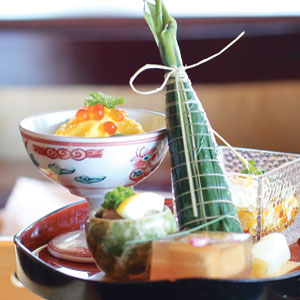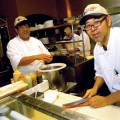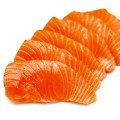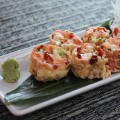Menlo Park’s Kaygetsu was one of my favorite restaurants. Kaygetsu specialized in kaiseki-style Japanese food, a rarefied, seasonally based multicourse meal that was as beautiful to behold as it was delicious to eat. Alas, Kaygetsu closed late last year when owners Toshio and Keiko Sakuma retired.
(Steve Jobs was a big fan of Kaygetsu and one of his last hires was tapping Toshio Sakuma as Apple’s sushi chef once Kaygetsu’s sale was in the works; Kaygetsu’s last day of business was the day of Jobs’ funeral.)
Meanwhile, Kaygetsu’s former kaiseki chefs are still making some great food. Katsuhiro Yamasaki left Kaygetsu to open the acclaimed Wakuriya in San Mateo, while co-chef Shinichi Aoki stayed put to become executive chef under new owner Tomonari Mitsunobu who redubbed the place Restaurant Mitsunobu. While both Aoki and Mitsunobu both have training in kaiseki, Restaurant Mitsunobu is not a kaiseki restaurant but a more casual, lower-priced California-kaiseki hybrid. Call it kaiseki-lite.
Mitsunobu says he wanted to give diners more choice when they order. A kaiseki meal is a set experience. Mitsunobu offers a four-course meal for $75 with two or more choices for each course. There’s a sake pairing for an extra $34, too. If you want the full kaiseki experience, they can do that as well.
There’s also a great menu of sushi, sashimi and small plates. Most of the fish is flown in from Japan (I don’t want to think about sushi’s carbon footprint), but the produce is locally sourced.
The very capable Mitsunobu mans the sushi bar in the spot formerly presided over by Sakuma. Overall, the experience is a notch or two less formal than Kaygetsu.
The restaurant occupies an anonymous, minimal space off Sand Hill Road. I think it used to be a bank. There are just eight tables and 30 seats, as well as a six-seat sushi bar. In spite of the surroundings, the dining room exudes calm and elegance. Dinner start with an amuse bouche—on my visits, a delicate, savory shrimp cake with a deep and delicious demitasse serving of dashi, the dried bonito-kombu-shitake broth that is the foundation of Japanese cooking.
The prix fixe meal changes each month to reflect the seasons and starts with a “jewelry box,” a tableau of miniature bites. It’s the best part of the meal.
The May menu included a bamboo-wrapped piece of smoked sockeye salmon nigiri tied up in a conical, hornlike shape to represent strength and masculinity. (In Japan, boys are celebrated in May, and in kaiseki style, the antlerlike dish is a symbolic representation of that.) The salmon itself is wonderfully rich and delicately smoky.
Then there’s a tiny quail egg cooked at 68 degrees and served on a bed of minutely chopped mountain yams in a savory, syrupy broth and dotted with a caviar; a tiny cup of raw, sweet shrimp seasoned with Japanese anchovy essence and lemon; a few asparagus tips atop a bright-yellow egg-yolk sauce with salmon glistening on top; and, finally, a square of foie gras encased in a translucent cube of cranberry-flavored gelatin. It’s all quite a sight and fun and delicious to eat.
Next up came the rice course. Rice is cooked to order rather than scooped out of a waiting steamer. I chose the clam and octopus rice cooked in a clay pot. It took a while, but the results were comforting and good. Compared to the first course, the rice dish was quite humble, just Manila clams, sliced pink octopus and a few bits of okra and green beans. The real star was the creamy and fragrant rice. A tiny spoon of fennel seed-perfumed salt is offered along side—a subtle but excellent addition to the dish.
In between the second and third course, one of the exceedingly polite and smooth servers slides in a palate refresher, in my case a yuzu-ginger-jalape–o granita. Very refreshing.
For my third course, I choose the “lightly fried” halibut cheeks. I put lightly fried in quotes because that’s how the menu described it, but what I got was coated in a thick, tempuralike batter than overwhelmed the fish. Pureed green peas and a tart, yogurtlike yuzu-flavored sauce helped offset the heavily battered fish.
My dessert choices were mochi and a molten matcha green tea cake. The cake was decent, especially with the barely sweet sesame ice cream on the side, but otherwise unremarkable.
My only complaint is the pacing between courses. Of course everything is cooked to order and good things take time, but the gaps between courses are just too long.
Restaurant Mitsunobu is not Kaygetsu, but it doesn’t aspire to be. With a more affordable menu and relaxed atmosphere it’s probably a better fit for the times. The food doesn’t scale the heights of its predecessor, but Aoki and Mitsunobu have created a unique dining experience you won’t find anywhere else that’s a welcome break from the sushi, tempura and noodle homogeneity at most Silicon Valley Japanese restaurants.
Restaurant Mitsunobu
325 Sharon Park Dr., Menlo Park
650.234.1084

 TECH UPDATE: Facebook Buys Karma; Kutcher Coming to Los Altos?
TECH UPDATE: Facebook Buys Karma; Kutcher Coming to Los Altos?  Bare Knuckle Pizza
Bare Knuckle Pizza 


